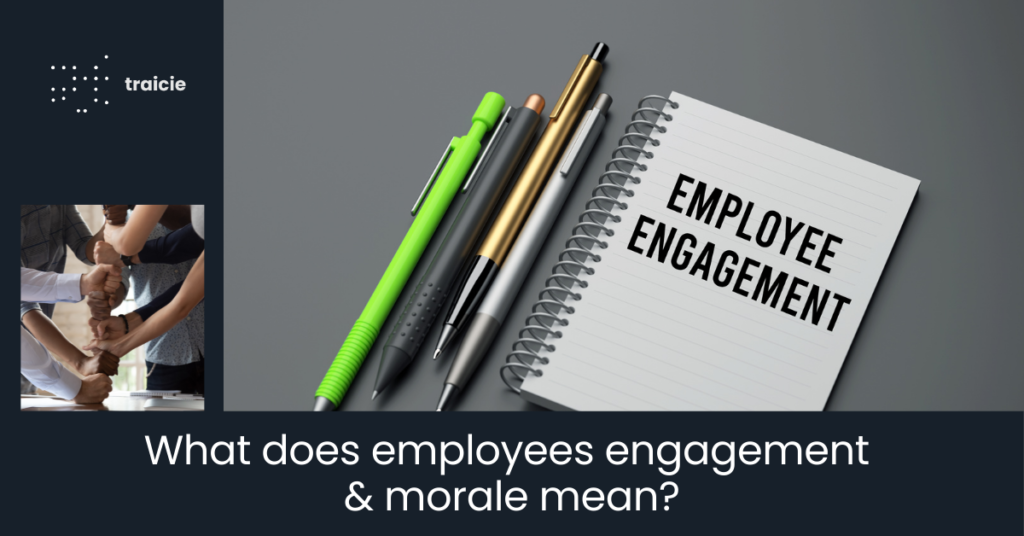Trends can change in the blink of an eye where we live. A method that works well today might not work as well tomorrow. The same goes for getting employees to work hard. Trends in employee engagement & morale change a lot with each new generation that joins the workforce. Business leaders and managers who are looking to the future must stay up to date on these engagement strategies.
Here are some statistics and trends about employee engagement and morale that are likely to be important in 2022. If you do these things your employees will be happier, more productive and more interested in their work.
Understanding your employees: ways to a better workplace

They say that employee engagement is “a workplace approach that creates the right conditions for all members of an organisation to give their best every day. It is committed to the goals and values of the organisation, motivates to contribute to the success of the organisation and provides a better sense of an employee’s well-being.”
Kevin Kruse, who wrote the book “Great Leaders Have No Rules”, indicated on Forbes that employee engagement differs from employee happiness. Kruse says that a worker can be happy and still not do their job well. He also says employee engagement is not the same as employee satisfaction because an employee can be satisfied and still not go the extra mile.
From what we’ve learned, we can say that employee engagement is when an employee cares about their company. This means that the employee cares about how well the company does, will stand up for it when it is criticised and is innovating new paths.
Engaged employees are open to change and are willing to come up with solutions to problems. They end up being the people on whom your business depends.
Why engaging employees & morale is essential?
Employee engagement & morale means that employees care more about their jobs and are willing to do their best even when the manager isn’t watching. Kruse said “When employees are engaged, businesses do better.”
Several other studies and surveys from reputable organisations, like the Harvard Business Review and the American analytics and advisory company Gallup, back up the positive effects of highly engaged employees.
In a survey of more than 500 business executives, the Harvard Business Review Analytic Services found that “71% of respondents ranked employee engagement & morale as very important to achieving overall business success.” Companies with engaged employees are likely to have an edge over their competitors. They also make more money.
| >>> Learn more about: 5 Useful Tips to Retain Valuable Employees in the Great Resignation.
Bamboohr.com, a company that makes HR software for small and medium-sized businesses, agrees that employee engagement & morale are more likely to stay at their jobs longer and help the business succeed. “Employees who feel engaged are more productive and happy in their jobs, but they are also more loyal to the company and more motivated to help the business succeed as a whole,” it says.
Interested in learning how traicie can help you to improve employee engagement and more by assisting you in mapping your company culture and finding the best candidates?
What factors affect employee engagement & morale?

The opinions and numbers above show how critical employee engagement & morale is. More importantly however, is what companies that want to increase employee engagement & morale should look at. Here are a few of them:
The Group/Company
Culture affects the way employees interact with an organisation. So, a key question about the organisation is whether or not there is a culture of engagement. This means looking at the rules about what motivates, respects and gives power to employees.
Also, the organisation needs to ensure that the employees understand the company’s goals and what they can do to help them.
The Supervisor
Managers significantly impact whether or not workers care about the companies they work for. Managers need to act and have the skills that encourage their employees to go the extra mile for the company.
Processes
To get employees to care about their jobs, companies need to set up processes that make the whole time they work there as easy as possible. For example, employees are engaged if a company has a smooth onboarding process.
Employees are likely to be excited if there are ways for them to share information, to get access to resources and to get the opportunity to learn and grow. These steps should also clarify what it takes to move up in the company.
| >>> Do you know that: Augmented Recruitment can source 23% more talent in 37% less time
Flexibility is another essential thing to consider, especially in times of Covid-19. In addition to having programs for employee health, company should ensure that they pay fairly for their talents. People are likely to work less motivated if they think their organisation doesn’t appreciate them.
Employee engagement & morale statistics
1. 87% of workers are not interested in what they do at work
Gallup’s report on the global workplace, State of the Global Workplace, says that only 13% of employees are engaged at work. This means that most people worldwide don’t like their jobs or only do the bare minimum to get through the day, with little to no emotional investment.
The study also shows that there are significant differences between countries. For example, 33% of U.S. employees are engaged at work, almost twice the average worldwide. On the other hand, only 10% of workers in Western Europe are interested in what they do at work.
2. 76% of workers think about leaving their jobs
A 2021 study found that 73% of workers would consider leaving their jobs for the right offer, even if they weren’t looking for work.
Changing jobs isn’t just about the money, as 69 percent of younger employees would take a pay cut to work at their dream job. Additionally, 31 percent of people looking for work indicated that they don’t require a pay increase to take a new position.
traicie can reduce your attrition and improve your retention significantly. Want to know how we do this?
3. Companies lose $420–525 billion yearly because their employees aren’t engaged
A study on employee engagement in the U.S. workplace found that disengaged employees cost companies $420 and $525 billion annually. Disengaged workers take less responsibility and ownership for their attitude, behaviour and motivation, which lowers overall productivity.
4. Companies with employees who are very involved in their jobs make 23% more money
Gallup’s meta-analysis found that the businesses or work units with the most engaged employees made 23 percent more money than those in the lowest quartile.
But we’re not there yet. A recent Interact/Harris Poll found that 91% of the employees surveyed think their leaders don’t know how to talk to people. The Edelman Trust Barometer says that almost one-third of employees do not trust their bosses. That’s scary.
5. A good company culture makes five times as much money
In a significant long-term study, companies with the best corporate cultures— encouraging leadership in all areas and showing their employees, customers and stakeholders that they care about them—saw their revenue grow by 682%.
During the same 11-year evaluation period, companies without a strong company culture saw their sales grow by only 166%. More than four times more money comes in when a company’s culture is strong.
6. 1/3 professionals say they leave their jobs because they are bored
According to a 2018 Korn Ferry survey, most people (33%) leave their jobs because they are bored or want new challenges. The second most common reason was that the work culture didn’t match employees’ or their values. The desire to make more money came in fourth, with only 19% of people saying that was the main reason they were leaving.
7. Only 25% of workers are happy with their chances to move up in their jobs
According to the SHRM study, 30% of employees thought learning and personal growth opportunities through their jobs were meaningful, but only 30% were happy with their current situation.
Younger generations care a lot about getting better at their jobs. A Gallup survey found that up to 87% of Millennials think taking action at work is essential.
Professional development is essential for employee engagement. Here, managers and HR staff need to give their employees the tools and resources they need to grow professionally.
Statistics about how the pandemic has changed employee engagement

- 88% of companies have encouraged or required their employees to work from home, even if they had no symptoms of the coronavirus (Gartner)
- Even though 60% of employers have made an effort to listen to their employees more often, few use formal listening methods. Only 31% hold surveys with their employees and only 13% hold focus groups (Willis Towers Watson)
- Only 47% of employers have the resources or plans in place to handle a crisis in the best way possible (Chief Executive)
- 22% of people who work from home say it’s hard to shut down after work (Buffer)
- Only 42% of employees are very sure that leadership is doing an excellent job of getting their company through the crisis (Perceptyx)
- Employees worked up to three hours more each day during the pandemic (Bloomberg)
- 20% of people who work from home say they don’t feel like they belong and sometimes feel lonely (Forbes)
- An employee’s mental health is 23% more likely to worsen if they say their boss is terrible at communicating. The Harvard Business Review says:
- 86% of workers say they feel like they have to prove to their bosses that they are working hard and deserve to keep their jobs (City)
- Since tracking started in 2000, the percentage of engaged employees in the U.S. reached its highest point in 2019. The rate of employee engagement in the U.S. rose from 34% in 2018 to 35% in 2019 (Gallup)
- In terms of employee engagement, Latin America has the highest score. About 60% of employees in the Latin America region say they had a good experience at work.
Statistics show how employee engagement affects keeping employees
- Customers rate organisations 10% higher if their teams are engaged than those not involved. This makes it more likely that an employee will leave, which costs the company about 1.5 times the employee’s original salary (Forbes).
- The U.S. will lose about $430 billion a year in 2030 because it won’t be able to keep its best workers. Improving employee engagement, which will positively affect retention rates, is a great way to deal with this and slow down this loss (Holaspirit).
- Employee engagement programs that work well have helped 30% of businesses in the U.K. keep more of their employees. This shows that companies can keep their employees if they take steps to make their jobs more enjoyable (Roberthalf).
- If your boss treats you respectfully, you’re 110% more likely to stay at your job than if they don’t (HBR).
- Getting your employees involved is a great way to keep them at your company. About 77% of companies focus on employee engagement to increase the number of people who stay with their company (LinkedIn).
| >>> You might also wonder about: Employee Turnover Rate: 8+ Strategies to Reduce [Updated]
Employee engagement & morale trends
- In most industries, older people are more interested in their jobs than younger people. People aged 40–49 and 50 or older are much more committed to their jobs than people aged 30–39 (ResearchGate).
- According to predictions, about 75% of people who work from home have fewer distractions, which will grow. In the next few years, workplace flexibility will become more critical. Because of the pandemic, we now know that many jobs don’t require people to be in the office daily (Flexjobs).
- As working from home becomes the norm, the cloud will start to gain more ground. Human Resources and other departments will look to the cloud to solve many problems in the workplace. About 35% of companies think about making plans to use the cloud to track remote workers’ productivity (PWC).
- About 85% of companies say their wellness programs help keep employees engaged (drive).
- As corporate branding becomes more important, employees will become the voice of their companies. When employees share news on social media, they respond 561% more than when the company shares the same information (Forbes).
Do you know that traicie’s sourcing tools for recruiters can help the hiring team with culture-based hiring but also in the strategic, operational value of the recruiting process :
- Cost of a job board – Reduce annual spending on job boards
- Cost of HR tools – Reduce the cost of surveys and assessment tools
- Recruitment costs – Reduce selection costs
- Internal mobility – Fill more skilled jobs with internal staff
- Time to hire – Reduce the number of days a role goes unfilled
- Salary costs – Reduce overall salary costs
- Attrition – Reduce the rate of turnover
- Recruitment cost – Reduce the general recruitment cost
One thought on “Employee Engagement & Morale Statistics Trends 2022 [Updated]”